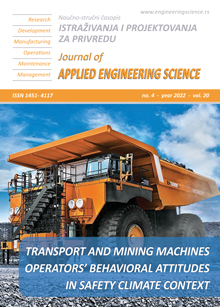IDENTIFICATION AND ASSESSMENT OF OCCUPATIONAL SAFETY RISKS IN CASE OF FAILURE TO CAPTURE AN ORPHAN SOURCE OF IONIZING RADIATION
Abstract
Occupational safety and health belong to fundamental human rights. This fully applies to the protection of employees and other persons, which operate or are located in facilities for the collection of scrap metal. The founder of the landfill or the employer has an irreplaceable place in the field of protection of persons against the effects of ionizing radiation. Based on the identification and assessment of occupational safety risks in the event of failure to ensure timely detection of an orphan source of ionizing radiation, the operator must assess all risk factors with emphasis on radiation. At the same time, it must take specific regime measures, which would minimize the impact on people and the environment. The article deals with the causes of failure the system of protection against the effects of ionizing radiation. The assessment of these causes is performed using the fault tree analysis method with the application of Boolean equations. The result of solving the problem is the calculation of the failure of the regime protection system in the devices, intended for the collection of scrap metal, caused by human error as a result of intentional or negligent actions of the operator and insufficient training in the areas of control of measuring devices, principles of correct use of detection devices, insufficient visual identification of potentially dangerous objects. The contribution of this paper is in the design of appropriate regime measures eliminating the consequences of non–capturing a source of ionizing radiation.
References
Bányai, T., Tamás, P., Illés, B., Stankevičiūtė, Ž., Bányai, Á. (2019). Optimization of municipal waste collection routing: Impact of industry 4.0 technologies on environmental awareness and sustainability. Int. J. Environ. Res. Public Health, 16. https://doi.org/10.3390/ijerph16040634.>
Bueno–Delgado, M.V., Romero–Gázquez, J.L., Jiménez, P., Pavón–Mariño, P. (2019). Optimal path planning for selective waste collection in smart cities. Sensors, 19. https://doi.org/10.3390/s19091973.>
Rai, R.K., Nepal, M., Khadayat, M.S, Bhardwaj B. (2019). Improving municipal solid waste collection services in developing countries: A case of Bharatpur Metropolitan City, Nepal. Sustain. 11. https://doi.org/10.3390/su11113010.>
Das, S., Bhattacharyya, B.K. (2015). Optimization of municipal solid waste collection and transportation routes. Waste Manag. 43. https://doi.org/10.1016/j.wasman.2015.06.033.>
Porterfield, D., Yano, K., Mao, K., Wharry, J. (2018). Investing in a permanent and sustainable nuclear waste disposal solution. Prog. Nucl. Energy, 108, p. 474–479.
Czechia (2006). Act No. 262/2006 Coll. The Labour Code. Collection of Laws. Amount 84/2006.
Jakubčík, M., Benčíková, E., Mihoková Jakubčeková, J., Tomek, M. (2020). System improvement of protection of employees against ionizing radiation from organ sources in scrap metal collection facilities. Waste Forum, 1, 33–44.
Czechia (2001). Act No. 185/2001 Coll. On waste and amending certain other laws. Collection of Laws. Amount 71, 4074–4113.
Czechia (2016). Act No. 263/2016 Coll. Atomic Act. Collection of Laws. Amount 102.
Czechia (2016). Decree No. 422/2016 Coll. Decree on radiation protection and security of a radionuclide source. Amount 172/2016.
State Office for Nuclear Safety (2017). Finding and capture of radionuclide sources in equipment intended for the construction, collection and processing of metal scrap, Radiation protection Recommendations DR–RO–4.1 (Rev.1.0). Ref. SÚJB/OS/20195/2017. Praha.
Profi Press (2019). How to proceed when finding nuclear material in scrap. Waste. 2, p. 31–34. from: https://www.sujb.cz/fileadmin/sujb/docs/radiacni-ochrana/dokumenty/Odpady_0219_31-35_opr.pdf, accessed on 2020-10-06.
International Atomic Energy Agency (2011). Control and Management of Radioactive Material Inadvertently Incorporated into Scrap Metal, Proceedings of an International Conference. Vienna, from: https://www-pub.iaea.org/MTCD/Publications/PDF/Pub1502_web.pdf, accessed on 2021-01-09.
State Office for Nuclear Safety. Annual reports. State Office for Nuclear Safety, Prague. 2015–2019, from: https://www.sujb.cz/dokumenty-a-publikace/vyrocni-zpravy, accessed on 2021-01-11.
Klener, V. et al. (2000). Principles and practice of radiation protection, first ed. State Office for Nuclear Safety, Prague.
Markulik, S., Kozel, R., Solc, M., Pacaiova, H. (2016). Causal dependence of events under management system conditions. MM Sci. J. https://doi.org/10.17973/MMSJ.2016_10_201620.>
Dafoe, A. (2018). Nonparametric Identification of Causal Effects under Temporal Dependence. Sociol. Methods and Res. 47. https://doi.org/10.1177/0049124115613784.>
Liu, Y., Fan, Z.P., Yuan, Y., Li, H. (2014). A FTA–based method for risk decision–making in emergency response. Comput. Operations Res. 42. https://doi.org/10.1016/j.cor.2012.08.015.>
Haegeman, K., Marinelli, E., Scapolo, F., Ricci, A., Sokolov, A. (2013). Quantitative and qualitative approaches in Future–oriented Technology Analysis (FTA): From combination to integration? Technolog. Forecast. Soc. Change. 80. https://doi.org/10.1016/j.techfore.2012.10.002.>
Sinay, J., Vargová, S. (2012). Identification of factors of stages of causal dependence of the occurrence of a negative phenomenon. Spectrum. Association of Fire and Safety Engineering, Ostrava;12. p. 49–51.
Czechia (2007). ČSN EN 61025. Fault state tree analysis (FTA). Czech Standards Institute, Prague.
Jakubčík, M. (2019). Mode of Protection against Ionizing Radiation from Orphan Sources in Metal Scrap Collectors. Zlín. Bachelor's thesis. TBU in Zlín.
Sánchez, A., Lozano, M., Villar, P., Herrera, F. (2009). Hybrid crossover operators with multiple descendents for real–coded genetic algorithms: Combining neighborhood–based crossover operators. Int. J. Intell. Syst. 24.
Liu, Y., Fan, Z.P., Yuan, Y., Li, H. (2014). A FTA–based method for risk decision–making in emergency response. Comput. Operations Res. 42. https://doi.org/10.1016/j.cor.2012.08.015.>
Trnecka, M., Trneckova, M. (2018). Data reduction for Boolean matrix factorization algorithms based on formal concept analysis. Knowledge–Based Syst. 158. https://doi.org/10.1016/j.knosys.2018.05.035.>
Ivanov, I., Pal, R., Dougherty, E.R. (2007). Dynamics preserving size reduction mappings for probabilistic Boolean networks. IEEE Trans. Signal Process. 55. https://doi.org/10.1109/TSP.2006.890929.>
Vintr, Z. (2015). Predictive reliability analyzes and possibilities of their use: Analysis of the tree of fault states. 1. Czech Society for Quality, Prague, from: https://www.csq.cz/fileadmin/user_upload/Spolkova_cinnost/Odborne_skupiny/Spolehlivost/Sborniky/CSJ_OSS_SBORNIK_2015_final.pdf, accessed on 2020-10-06.
Coneva, I. (2012). Solving leakages of dangerous substances at traffic accidents with sorbent usage. Protection of the living conditions of the population. Environmental protection of population: 7th Scientific International Conference. VŠKE, Brno, p. 57–68.
International Atomic Energy Agency (2012). Control of Orphan Sources and Other Radioactive Material in the Metal Recycling and Production Industries. Specific Safety Guide. No. SSG–17. International Atomic Energy Agency, Vienna.

